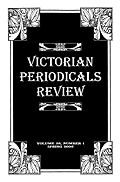 Victorian Periodicals Review
Victorian Periodicals Review publishes in its last issue (Spring 2006, Volume 39, Issue 1) the following article:
"The Brontë Sisters and the Christian Remembrancer: A Pilot Study in the Use of the 'Burrows Method' to Identify the Authorship of Unsigned Articles in the Nineteenth-Century Periodical Press" by Ellen Jordan, Hugh Craig and Alexis Antonia.
The authors of the article have been so kind as to forward us the paper so that we can discuss it properly.
Quoting Susan Bailey in Brontë Studies (Volume 27, Nov 2002, p. 219):
The Anglican periodical, The Christian Remembrancer; or, the churchman's Biblical, ecclesiastical and literary miscellany, ran from 1819 to 1868, edited first by Frederick Iremonger, and beginning in 1841, by William Scott. In 1844, it changed from a monthly to a quarterly publication (...) Also in 1844, James Mozley became co-editor with Scott. (...)
Many of the contributors to The Christian Remembrancer were clergymen who wrote on church history, theology, or topical subjects. (...) Despite its predominantly High Church leanings, this periodical included a fair amount of literary content. Probably its best known literary review is the one of Georgiana Fullerton's Lady Bird and Charlotte Bronte's Villette (Apr. 1853) by Anne Mozley, sister to the editor J. B. Mozley, which complains about the 'unscrupulous' and 'self-dependent intellect' of Lucy Snowe.
That review, which caused Charlotte Brontë to address the Christian Remembrancer editors, was not the only one to deal with Brontë material: in 1848 a review of Jane Eyre, in 1851 an article called 'Minor Poets of the Day', where the book of poems published by the sisters in 1846 was discussed with other recent publications and in 1853 Villette was reviewed in an article called 'New Novels by Lady G. Fullerton and Currer Bell'. Finally in 1857, a review was published of Gaskell's Life of Charlotte Brontë.
According to Jordan, Craig and Antonia:
The academic literature on the reception of the Brontë novels characterises the Christian Remembrancer's response as hostile, along with that of Elizabeth Rigby and Matthew Arnold. (...) The Christian Remembrancer reviews acknowledged the strenghts of the Brontës' work, but they, too, took issue with their morality and their subject matter.The only one of those reviews that has an attributed author is the one on Villette. The reviewer seems to be Anne Mozley (1809-1891), journalist and sister of James Mozley, the editor. The authors of the article state that this attribution is not very strong as
the citations going no further back than to an assertion of her authorship made by Robertson W. Nicoll in an address to the Brontë Society in 1919.What the authors of the article propose is to use the Burrows method, a statiscal approach to attribute authorship based on the analysis of what are called "function" words in the body of work of some particular author as compared with other contemporary authors. The interested reader can found the technical details in
the CLLC website.
Their conclusions are the following:
Anne Mozley did review Villette and Gaskell's Life with a high degree of probability. Mozley is also very likely to have reviewed the Poems, but the attribution is not so strong. Finally, the review on Jane Eyre was definitely not penned by Anne Mozley.
Categories: Journals, Scholar, Charlotte_Brontë









0 comments:
Post a Comment